History of the Jews in Morocco
Moroccan Jews constitute an ancient community. Before the founding of Israel in 1948, there were about 250,000 to 350,000 Jews[1] in the country, which gave Morocco the largest Jewish community in the Muslim world, but by 2017 only 2,000 or so remain.[2] Jews in Morocco, originally speakers of Berber languages, Judeo-Moroccan Arabic or Judaeo-Spanish, were the first in the country to adopt the French language, and unlike the general population French remains the main (and, in many cases, the exclusive) language of members of the Jewish community there.[3]
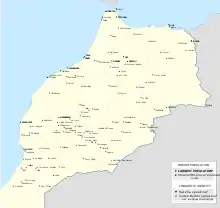
| Part of a series on |
| Jews and Judaism |
|---|
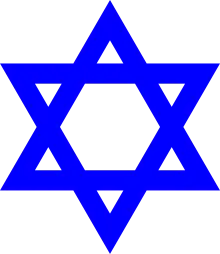 |
|
History
Under the Romans
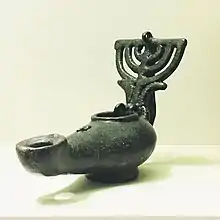
The Jewish presence dates back over 2,500 years, to the time of the Carthaginian state. The Hebrew or Aramaic languages used by Jews were closely related to the Punic language of the Carthaginians; many Jews also settled amongst Berbers and adopted their languages. Later, under the dominion of the Romans and (after 429) the Vandals, Mauretanian Jews reportedly increased in number and prospered.
As Christianity was adopted by the Roman state, the church Councils of Carthage adopted policies that discriminated against adherents to Judaism. The Justinian edict of persecution for North Africa, issued after Vandal rule had been overthrown and Mauretania had come under the dominion of the Byzantines (534), was directed against the Jews as well as the Arians, the Donatists, and other dissenters.[4]
In the 7th century, the Jewish population of Mauretania received as a further accession from Iberian Peninsula those who wished to escape Visigothic legislation. At the end of the same century, at the time of the great Arab conquests in northwestern Africa, there were in Mauretania, according to the Arab historians, many Jews.
Arab conquest and the Idrisids (703–1146)
Since the city of Fez was founded in 808 CE, it attracted a diverse kind of population from all around the area, among those new newcomers came the Jews who contributed their commercial capabilities to the new developed economy. They settled in the medina of Fez, and formed a stable community, which was an integral part of the city life.[5] The golden age of the Jewish community in Fez lasted for almost three hundred years, from the 9th to 11th centuries. Its yeshivot (religious schools) attracted brilliant scholars, poets and grammarians. This period was marred by a pogrom in 1033, which is described by the Jewish Virtual Library as an isolated event primarily due to political conflict between the Maghrawa and Ifrenid tribes.[6]
Under the Almoravids
The Almoravids (Arab. Al-Murābiṭūn; "Warrior-Monks"), confederation of Berber tribes of the Sanhajah group who lived in the Moroccan Sahara Desert. Their religious fervor and fighting capabilities enabled them to establish a formidable empire in the Morocco and Muslim Spain in the 11th and 12th centuries. Their theological Islamic zeal is attributed to Yahya ibn Ibrahim, their spiritual leader, as well as to the 'alim (religious scholar) 'Abd Allah ibn Yasin. Imbued with Islamic zeal, the Almoravids conquered Morocco and major sections of western Algeria between 1054 and 1092. In 1062 they turned Marrakesh into their base of operations and religious capital. Thenceforth, their main leaders embraced the title of Amir al-Muslimin ("commander of the Muslims") but nevertheless continued to recognize the legitimacy of a still higher authority in Islam: the Abbasid caliph in Iraq upon whom the title Amir al-Mu'minīn ("commander of the faithful") had been bestowed. It was toward the end of the 11th century that the Castilian Christians who held on to parts of Spain began challenging the authority of the Almoravids and encroaching on their territories. The Almoravid leadership succeeded in temporarily repulsing the Christians and foiling their plans to conquer such key cities as Córdoba and Toledo.
With the exception of Valencia, Muslim Spain remained under Almoravid control. Notwithstanding, perhaps the weakest aspect of Almoravid rule in Spain and the Maghreb is the fact that they were a Muslim Berber minority in charge of a Spanish-Arab empire. With the passage of time, they found it increasingly difficult to protect all their territorial possessions from the Christian reconquest, especially in the aftermath of the fall of Saragossa in 1118. Moreover, in 1125 the Almohads (those who advocated the "Unity of Allah"), a confederation of rival Berber tribes, began to rebel against them in the Atlas Mountains. Following a protracted struggle and relentless fighting, the Almohads defeated the Almoravids in 1147; they transformed Marrakesh into their own capital and extended their authority into Muslim Spain.
The position of the Jews under Almoravid domination was apparently free of major abuses, though there are reports of increasing social hostility against them – particularly in Fes.[7] Unlike the problems encountered by the Jews during the rule of the Almohads (the Almoravids' successor dynasty), there are not many factual complaints of excesses, coercion, or malice on the part of the authorities toward the Jewish communities. It is known, however, that Yusuf Ibn Tashfin forbade Jews living in the capital city Marrakesh. It was allowed for them to trade there, but if a Jew was caught in the city during night hours it was punishable by death.[8]
Under the Almoravids, some Jews prospered (although far more so under Ali III, than under his father Yusuf ibn Tashfin). Among those who held the title of "vizier" (وزير) or "nasih" (ناصح) in Almoravid times were the poet and physician Abu Ayyub Solomon ibn al-Mu'allam, Abraham ibn Meïr ibn Kamnial, Abu Isaac ibn Muhajar, and Solomon ibn Farusal.
Under the Almohads (1146–15th century)
The Dhimmi status, which called for the payment of jizya (taxes for non-Muslims) in exchange for a certain level of protection for religious minorities, came to an end under the strict militant dynasty of the Almohads, who came into power in 1146. Instead, the Almohads forced Jews to choose between conversion to Islam or death, compelling many Jews to convert, or at least pretend to. Due to the many similarities between Jewish and Islamic practice, Jews felt as though they could clandestinely maintain their Jewish practices under the guise of Islam.[9] For example, names such as Benchekroun (initially Chokron or Choukroun or Chekroun depending on the pronunciation), El Kohen, and Kabbaj were Jewish in origin. Maimonides, who was staying in Fez with his father, is said to have written to the communities to comfort and encourage his brethren and fellow believers in this time of oppression [10] In the above-mentioned elegy of Abraham ibn Ezra, which appears to have been written at the commencement of the period of the Almohads, and which is found in a Yemen siddur among the kinot prescribed for the Ninth of Ab, the Moroccan cities Ceuta, Meknes, the Draa River valley, Fez, and Segelmesa are especially emphasized as being exposed to great persecution. Joseph ha-Kohen[11] relates that no remnant of Israel was left from Tangier to Mehdia.
Due to the nature of the forced conversions, the later Almohads were no longer content with the repetition of a mere formula of belief in the unity of God and in the prophetic calling of Muhammad. The third Almohad Prince, Abu Yusuf Ya'qub al-Mansur, spoke on this matter, saying “If I were sure about the sincerity of their Islam, I would let them mix with the Muslims..., and if I were sure of their unbelief, I would kill their men, enslave their offspring, and declare their property spoils for the Muslims. But I am uncertain about their case.”[9] Thus, al-Mansur made an effort to distinguish the neo-Muslims from the “true” Muslims. He compelled them to wear distinguishing garments, with a very noticeable yellow cloth for a head-covering; from that time forward the clothing of the Jews formed an important subject in the legal regulations concerning them.
The reign of the Almohads on the whole exercised a most disastrous and enduring influence on the position of the Moroccan Jews. Already branded by their clothing as unbelievers, they furthermore became objects of scorn and violent despotic caprice from which there was no escape.
An account by Solomon Cohen dated January 1148 CE describes the Almohad conquests:
"Abd al-Mumin ... the leader of the Almohads after the death of Muhammad Ibn Tumart the Mahdi ... captured Tlemcen [in the Maghreb] and killed all those who were in it, including the Jews, except those who embraced Islam. ... [In Sijilmasa] One hundred and fifty persons were killed for clinging to their [Jewish] faith. ... One hundred thousand persons were killed in Fez on that occasion, and 120,000 in Marrakesh. The Jews in all [Maghreb] localities [conquered] ... groaned under the heavy yoke of the Almohads; many had been killed, many others converted; none were able to appear in public as Jews."[12]
Under the Marinids
The Marinid dynasty (Berber: Imrinen, Arabic: Marīniyūn) was a dynasty of Zenata Berber descent that ruled Morocco from the 13th to the 15th century.[13][14]
The Marinids overtook the Almohads controlling Morocco in 1244,[15] and briefly controlled all the Maghreb in the mid-14th century. They supported the Kingdom of Granada in Al-Andalus in the 13th and 14th centuries; an attempt to gain a direct foothold on the European side of the Strait of Gibraltar was however defeated at the Battle of Salado in 1340 and finished after the Castilian conquest of Algeciras from the Marinids in 1344.[16]
During Marinid rule, Jews were able to return to their religion and practices, once again outwardly professing their Judaism under the protection of the dhimmi status. They were able to re-establish their lives and communities, returning to some sense of normalcy and security. They also established strong vertical relations with the Marinid sultans.[17] When the still-fanatic mobs attacked them in 1275, the Merinid sultan Abu Yusuf Yaqub ibn Abd Al-Haqq intervened personally to save them. The sovereigns of this dynasty benevolently received the Jewish ambassadors of the Christian kings of Spain and admitted Jews among their closest courtiers. Of these Jews, Khalifa b. Waqqāsa (Ruqqasa) became steward of the household of the sultan Abu Yaqub Yusuf an-Nasr and his intimate counselor. A victim of palace intrigues, he was put to death in 1302. His nephew, who was also named Khalifa, held the same office and suffered the same fate (1310). However, there were no repercussions against the Moroccan Jews as a result of the execution of their powerful coreligionists. They were the principal factors in the prosperity of the country. The Sahara gold trade, which was of primary importance, and the exchange with the Christian countries were completely under their control. Their relatives and associates in the kingdom of Aragon financed, when necessary, the navies which defended the Moroccan ports. In addition to the jizya (tax paid by non-Muslims), they paid enormous sums to the treasury in customs duties for their imports and exports. In the outlying areas, particularly in the Atlas region where there were large concentrations of Jews of early origin, the Jews wielded great influence in both the political and spiritual domains. Jewish physicians enjoyed well-deserved renown. The study of Kabbalah, as well as philosophy, was then in vogue. The last Moroccan philosopher of the Middle Ages was Judah b. Nissim ibn Malkah, who was still alive in 1365.
The last ruler of the Marinid dynasty, Abd al-Haqq II, appointed many Jews to high positions. The appointment of Jews to high positions, such as vizier, angered many Muslims, as they viewed such increases in Jewish power as transgressing the dhimmi status. Abd al-Basit b. Khalil, a medieval Moroccan author, claims that Jews became arrogant with their newfound prestige, using their power to command Muslims. This is a clear disruption to the established social order. Once a rumor began to circulate that the Jewish vizier in Fez, Aaron Batash, struck a Muslim woman, there were public outcries amongst Fez's Muslim population. They demanded the Mufti (Islamic legal expert) to issue a Fatwa (legal opinion) to permit the killing of Jews in the name of the Allah. The Mufti had no choice but to make these killings permissible. Thus, began the 1465 Moroccan revolt, one of the worst pogroms in Morocco's history.[18]
The Spanish Expulsion of the Jews
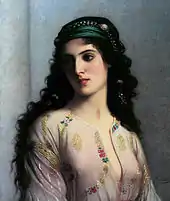
By 1249, the Spanish Reconquista had concluded its main phase. During the murderous scenes enacted in 1391 in Spain, Spanish-controlled Seville, and Majorca, the Sephardi Jews of Spain seized the opportunity to emigrate to North Africa in order to escape persecution. A hundred years later, King Ferdinand II of Aragon and Queen Isabella I of Castile issued the Alhambra Decree - an edict ordering the expulsion of practicing Jews from Spain. Consequently, the Jews were driven from Spain in 1492, and later from Portugal in 1496 following a similar decree by King Manuel I of Portugal. The sudden inroad of Jews into Morocco and the whole of North Africa was then repeated on a much larger scale.
Following the 1465 Moroccan revolt under the Marinid dynasty, the native Jewish community in Morocco had shrunken substantially, having been massacred and marginalized. The Moroccan Jewry began to recover from the pogroms of 1465 under the Wattasid dynasty, a ruling group of Zenata Berbers which had gained control during the fall of the Marinid in 1472. The Jewish community in Morocco then swelled with the waves of refugees arriving from Spain and Portugal after 1492, increasing the cultural and economic power of the Moroccan Jewish community considerably. Incoming Sephardi Jews tended to be economically better off than their native counterparts, bringing with them specific ideas of culture shaped by centuries of life on the Iberian Peninsula. As a result, the Sephardic scholarly mercantile elite were quick to dominate Jewish communal life in Morocco.[19]

A number of natives from Fez fled to Spain over the course of the fifteenth century and returned to Fez following 1492, acting as a unique bridge between the native Jews of Morocco and the newly arrived Sephardim. Among this group, the most outstanding representatives were the Ibn Danan family. Fleeing from Fez in either 1438 or 1465, the Ibn Danans settled in Granada where Rabbi Moses Maimon Ibn Danan and his son Saadiah achieved fame as scholars. Saadiah returned to Fez after the Spanish expulsion and served as a spiritual guide for other exiles, whilst identifying himself with the native Jews. The Ibn Danan family was among the intellectual and financial elite of Fez for centuries, creating alliances across Sephardi families and maintaining a prominent synagogue in Fez.[20]
The arrival of Spanish Jewish refugees brought important changes in city life and within the preexisting Jewish community. Jewish life in the Muslim interior of Morocco became dominated by the Sephardic plutocracy that continued to maintain control of the Moroccan Jewry up until modern times. Each local community had a rigid, or shaykh al-Yahud, who was appointed by the government. The chief figure in the larger Jewish community was the Nagid of the capital, who was invariably a court Jew.[19] Throughout the Moroccan Jewish community, there were famous Sephardic dayyanim such as the Ibn Danans whose authority was largely recognized by Jews within the whole country.[5][21] However, the influx of refugees also caused overcrowding in the larger cities of Morocco and aroused uneasiness among both the Muslims, who feared an increase in the price of necessities, and the Jews already settled there, who had hitherto barely succeeded in creating a livelihood in handicrafts and petty commerce.
While many Spanish Jewish exiles to Morocco were able to successfully integrate into the larger community in part due to their relative wealth, the problem of poverty among exiles still left a significant number of Jewish refugees vulnerable.[22] Many died of hunger and some returned to Spain;[23] most fled to Fez, where new challenges awaited them. More than 20,000 Jews died in and around Fez following a terrible fire and subsequent famine in the Jewish quarter of the city.[22]
Despite the trials faced by Jews in Morocco, numerous "New Christians" - also referred to as "Marranos" - that still remained in Spain and Portugal following the expulsions endeavored to make their way to North Africa. In response to this, King Manuel I issued a number of ordinances in 1499 forbidding the emigration of New Christians without explicit royal permission. Nevertheless, with monetary and transportive aid from figures already established in the Jewish diaspora, many New Christians succeeded in immigrating to North Africa.[24]
A new group of New Christians came to Morocco through the establishment of the Inquisition in Portugal under Pope Paul III in 1536.[25] In 1508, Portugal had come to occupy parts of Morocco, succeeding in conquering the old seaport town of Safi, which had a large number of Jewish inhabitants and had subsequently become an important commercial center.[26] In 1510, Safi was besieged by a large Moorish army. Following this, some Portuguese Jews brought assistance to the besieged with ships manned by coreligionists and equipped at their own cost.[26]
In Safi, the Jews were allowed to live as such by King Manuel I's permission; in addition to Asilah after 1533, which had long been a Portuguese possession.[22] In the quarrels which took place afterwards between the Moors and the governors of Azamur, the Wattasid sultans employed some of the well-connected immigrants as commercial and diplomatic go-betweens with the Portuguese crown. Men such as Rabbi Abraham b. Zamiro of Safi, and Jacob Rosales and Jacob Rute of Fez, were as much agents of Portugal as Morocco. The Wattasids also took in their service some Jewish artisans and technicians who possessed strategic military skills. These men were employed in much the same spirit as Christian mercenaries, and were generally not considered to be government officials with any administrative authority over Muslims.[19]
Under Saadi dynasty
The Saadi dynasty or Saadian dynasty was a dynasty of Arab descent that ruled Morocco from 1554 to 1659.
From 1509 to 1554 they had ruled only in the south of Morocco. While still recognizing the Wattasids as Sultans until 1528, Saadian's growing power led the Wattasids to attack them and, after an indecisive battle, to recognize their rule over southern Morocco[27] through the Treaty of Tadla.
Their reign over Morocco began with the reign of Sultan Mohammed ash-Sheikh in 1554, when he vanquished the last Wattasids at the Battle of Tadla. The Saadian rule ended in 1659 with the end of the reign of Sultan Ahmad el Abbas. When, in 1578, the young king Sebastian with almost his whole army met death, and Portugal saw the end of her glory, in the Battle of Alcazarquivir, the few nobles who remained were taken captive and sold to the Jews in Fez and Morocco. The Jews received the Portuguese knights, their former countrymen, into their houses very hospitably and let many of them go free on the promise that they would send back their ransom from Portugal.[28]
Samuel Pallache of the Sephardi Pallache family, having earned the confidence of Zaydan An-Nasser, had a significant role in Morocco–Netherlands relations, serving as the interpreter for his embassador Hammu ben Bashir in a journey to the Dutch Republic, then again with Ahmad ben Abdallah al-Hayti al-Maruni, which led to the signing of the Dutch-Moroccan Treaty of Friendship and Free Commerce in 1611.[29]
Numerous newly immigrated Jews, whose descendants faithfully adhere to the use of their Spanish dialects, Ladino and Haketia to the present day and who surpass older Jewish Moroccans in education and intellectual achievement, subsequently become prominent in Moroccan history. With their skill in European commerce, arts, and handicrafts, hitherto largely unknown to the Moors, and with their wealth, Jews have contributed conspicuously to the rise and development of the Alaouite Dynasty since its beginning in 1666.[30] At first the Sa'dis appeared to be fanatical religious zealots who were intolerant of non-Muslims. They imposed heavy taxes on the local Jewish community. As they consolidated their authority in the country, however, they gradually evinced greater toleration toward the Jewish minority. Like their Wattasid predecessors, the Sa'di sultans now employed Jews as physicians, diplomatic emissaries, and interpreters. Beginning in 1603, Abraham bin Wach and later Judah Levi served as ministers of the treasury. Members of the Jewish aristocratic Cabessa and Palache families were recruited by the sultan's court as agents and negotiators with European merchants who entered the country. Whereas the authorities increasingly proved to be friendly toward the Jews, the same could hardly be said of the Muslim masses as well as local urban and rural chieftains and governors.[31]
Under Moulay Rashid and Moulay Ismail
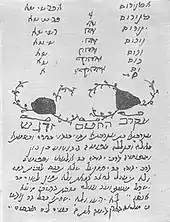
The Jews suffered much during the great conquests of Moulay Rashid, who united the separate parts of Morocco into one single state, and wished to add to it all northwest Africa. According to Chénier, when Al-Raschid took the city of Marrakech in 1670, at the desire of the inhabitants he caused the Jewish counselor and governor of the ruling prince Abu Bakr, together with the latter and his whole family, to be publicly burned, in order to inspire terror among the Jews.[32] He also tore down the synagogues of the city, expelled many Jews from the Berber region of Sus and treated them tyrannically. His demands on the Jews in the way of taxes were enormous; he had them collected by Joshua ben Hamoshet, a rich Jew, to whom he was under obligations for various services and whom he appointed chief over the Jews. He even ordered the Jews to supply wine to the Christian slaves.
In 1668 the Jewish community of Chaouya settled in Fez after Mulai Rashid attacked the town of Chaouya. They were given three days to leave and left with their rabbi Maimon Aflalo. They numbered around 1300 households and possessed great wealth. After they moved to Fez they were granted their own synagogue .[21]
Moulay Rashid's successor was his brother Ismail (Moulay Ismail) (1672), one of the cruelest of tyrants. On his accession Ismail appointed his Jewish adviser Joseph Toledani, son of Daniel Toledani, Moulay Raschid's counselor, to be his minister, in which capacity Joseph concluded a peace between Morocco and Holland. Under Ismail's rule the ruined synagogues were rebuilt, although his taxes on Jews were oppressive. One day, he threatened to compel them to accept Islam if their Messiah did not come within a definite time. The Jews understood the hint and satisfied his pious zeal with a very large sum of money.[33] The Jews, who served as tax-collectors on the whole coast, used to give Ismail a golden riding-outfit as an annual "present"—an inducement to keep them in office—and a hen and a dozen chickens fashioned in gold as a tax payment for the whole Jewish community.[34] Ismail had another way of securing money: for a certain sum he would sell to an aspirant for honors the position and wealth of one of his favorites. In one such transaction Maimaran, who was chief ruler over the Jews of the realm, feared a rival in Moses ibn 'Attar, and offered the sultan a certain sum for his head. Ismail then let Moses ibn 'Attar know how much had been offered for his head, whereupon Ibn 'Attar offered double the sum for the head of his opponent. The sultan took the money from both, called them fools, and reconciled them to each other, whereupon Ibn 'Attar married a daughter of Maimaran and shared with his father-in-law reign over the Jews. The same Moses ibn 'Attar was Moorish plenipotentiary in the making of a compact with Great Britain in 1721.
After 1700 Fez no longer attracted as many Jews as in the previous centuries, while others still continued to arrive, other retained residence in Fez, while spend their time elsewhere.[21]
In 1703 a controversy happened between the Jews of Chaouya residing in Fez to the rest of the Jewish community. They demanded from their communal leaders that the governmental taxes will be assessed for them separately. Furthermore, they had a bad relations with the rest of the community, and tried to form separate agreements with the government. Those two events, did not passed on eventually.[21]
The two communities, those who came from Spain (megorashim) and the locals, finally melded together. Arabic was the main language, while unique Spanish rituals were kept and practiced. The number of the community members fluctuated through the following years. There were times of relative peace and times of epidemics and different crises. For example, in 1723 an extended drought transformed the mellah into a ghost town as many Jews escaped and abandoned the area. "The houses of the rich are empty, their inhabitants have disappeared, the gates of the courtyards are closed, weeds grow up and robbers enter, stealing the doors and the beds. Many houses have been demolished, their stones and rafters taken away.... Most of the streets of the mellah are deserted." Hunger took the lives of more than 2000 people and 1,000 more converted from Judaism.[35][21]
In the 18th century

The condition of the Jewish community was unchanged under Mohammed III (1757–89), who distinguished himself by his attempt to introduce European culture into his kingdom. The Jews counciliers of Mohammed Ben Abdelah helped United States between 1776 and 1783 through Intelligence operations coordinated by Luis de Unzaga 'le Conciliateur' and his brothers-in-law Antonio and Matías de Gálvez via Canary Islands and Louisiana.[36] The Sultan's eldest son, Moulay Ali, governor of Fez, courageously opposed his father's suggestion to impose a tax upon that city in favor of his other brothers, which tax was to be paid by the Jewish community. He stated that the Jews of Fez were already so poor that they were unable to bear the present tax and that he was not willing to increase still further their misery.[37] His minister was the Jew Elijah ha-Levi, who had at one time fallen into disgrace and had been given as a slave to a smuggler of Tunis, but had been restored to favor.[38] The accession to the throne of Yazid, on the death of Mohammed III in 1789, led to a terrible massacre of the Moroccan Jews, having refused him their support in his fight with his brother for the succession. As a punishment the richer Jews of Tetouan, at his entry into the city, were tied to the tails of horses and dragged through the city. Many were killed in other ways or robbed. Jewish women were raped. The Spanish consul, Solomon Hazzan, was executed for alleged treachery, and the Jews of Tangier, Asilah, and Alcazarquivir were condemned to pay a large sum of money. Elijah, the minister of the former king, who had always opposed Yazid in the council, quickly embraced Islam to avoid being persecuted. He died soon after. The cruelty of the persecutors reached its climax in Fez. In Rabat, as in Meknes, the Jews were ill-treated. In Mogador, strife arose between the Jews and the city judge on the one hand, and the Moorish citizens on the other; the dispute was over the question of Jewish garb. Finally the Jews were ordered to pay 100,000 piasters and three shiploads of gunpowder; and most of them were arrested and beaten daily until the payment was made. Many fled beforehand to Gibraltar or other places; some died as martyrs; and some accepted Islam.[39] The notables and the Muslim masses then rose to intervene on behalf of the Jews. They hid many of them in their houses and saved a great many others. In Rabat, the governor Bargash saved the community from the worst.[40] The sanguinary events of the year 1790 have been poetically described in two kinot for the Ninth of Ab, by Jacob ben Joseph al-Mali? and by David ben Aaron ibn Husain.[41]
From the second half of this century various accounts of travels exist which give information concerning the external position of the Jews. Chénier, for example, describes them as follows:
"The Jews possess neither lands nor gardens, nor can they enjoy their fruits in tranquillity. They must wear only black, and are obliged when they pass near mosques, or through streets in which there are sanctuaries, to walk barefoot. The lowest among the Moors imagines he has a right to ill-treat a Jew, nor dares the latter defend himself, because the Koran and the judge are always in favor of the Mohammedan. Notwithstanding this state of oppression, the Jews have many advantages over the Moors: they better understand the spirit of trade; they act as agents and brokers, and they profit by their own cunning and by the ignorance of the Moors. In their commercial bargains many of them buy up the commodities of the country to sell again. Some have European correspondents; others are mechanics, such as goldsmiths, tailors, gunsmiths, millers, and masons. More industrious and artful, and better informed than the Moors, the Jews are employed by the emperor in receiving the customs, in coining money, and in all affairs and intercourse which the monarch has with the European merchants, as well as in all his negotiations with the various European governments."[42]
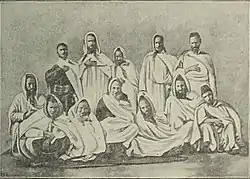
There were, indeed, quite a number of such Jewish officials, negotiators, treasurers, councilors, and administrators at the Moroccan court, whom the European is inclined to call "ministers", but whom in reality the ruler used merely as intermediaries in extorting money from the people, and dismissed as soon as their usefulness in this direction was at an end. They were especially Jews from Spain, the megorashim, whose wealth, education, and statesmanship paved their way to the court here, as formerly in Spain. One of the first of such ministers was Shumel al-Barensi, at the beginning of the 16th century in Fez, who opened the "state career" to a long succession of coreligionists ending in the 19th century with Masado ben Leaho, prime minister and representative councilor of the emperor in foreign affairs. It would be erroneous to suppose that these Jewish dignitaries of the state succeeded in raising the position and the influence of their fellow believers, or that they even attempted to do so. They were usually very glad if they themselves were able to remain in office to the end of their lives.
Moroccan Jews were employed also as ambassadors to foreign courts. At the beginning of the 17th century Pacheco in the Netherlands; Shumel al-Farrashi at the same place in 1610; after 1675 Joseph Toledani, who, as stated above, concluded peace with Holland; his son Hayyim in England in 1750; a Jew in Denmark. In 1780 Jacob ben Abraham Benider was sent as minister from Morocco to King George III; in 1794 a Jew named Sumbal and in 1828 Meïr Cohen Macnin were sent as Moroccan ambassadors to the English court.[43][44]
Another event caused to a population decrease among the community was the two-year exile of the Jews from the mellah in 1790–1792, during the brief reign of sultan Malawy yazid . The whole community was forced to leave to Qasba Shrarda which was on the other side of Fez. This time the population of the Jews around the mellah was at the lowest stage of all time, and did not manage to "heal" itself. A mosque was built on the site of the main synagogue, under the order of yazid, tomb stones from a near Jewish cemetery was used to built the mosque, and the cemetery itself was moved to the entrance of the Muslim quarter along with the bones of the saintly rabbis. The exile lasted around for two years, and only after the death of yazid, the qadi of Fez ordered the mosque to be torn down and the Jews were permitted to return to their quarter.[5][6][35]
In the 19th century
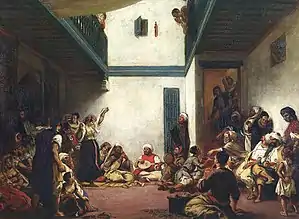
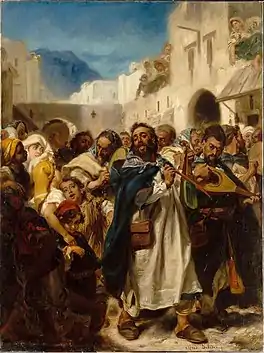
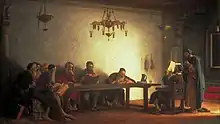
The 19th century, which brought emancipation to the Jews of many countries, failed to fundamentally alter the status of Moroccan Jews, but produced new divisions among them and entailed new sources of trouble. In the mid 19th century, commercial development and European economic penetration brought prosperity to many Jewish merchants in northern Moroccan ports, but cost many Jews in the interior their traditional livelihoods,[45] as industrial imports from Europe drove traditional Jewish crafts out of the market.[46] As a result, Moroccan Jews started migrating from the interior to coastal cities such as Essaouira, Mazagan, Asfi, and later Casablanca for economic opportunity, participating in trade with Europeans and the development of those cities.[47] Some impoverished migrants to overpopulated urban mellahs (Jewish quarters) struggled to survive as shopkeepers, peddlers, artisans or beggars.[48][49]
Morocco's instability and divisions also fueled conflicts, for which Jews were frequent scapegoats. The First Franco-Moroccan War in 1844 brought new misery and ill treatment upon the Moroccan Jews, especially upon those of Mogador (known as Essaouira).[50] When the Hispano-Moroccan War broke out on September 22, 1859, the Mellah of Tetuan was sacked, and many Jews fled to Cadiz and Gibraltar for refuge.[51][52]
Alliance Israélite Universelle
This incident in the Battle of Tétouan of 1860 was covered by the European Jewish press, which led to an international effort called "The Morocco Relief Fund."[52] The persecution of Moroccan Jews was one of the motives for the foundation in 1860 of the Alliance Israélite Universelle (AIU), a French-based organization working for Jewish social and political equality and economic advancement worldwide.
Morocco was one of the countries where the AIU was most active; it opened its first school in Tetuan in 1862, followed by schools in Tangier (1864), Essaouira (1866), and Asfi (1867).[53][52] Eventually, it had 83 schools in Morocco, more than in the rest of the world combined.[54] Over time, the AIU in Morocco was more and more closely associated with French colonial influence;[55] one of its assistant secretary-generals later noted that its "close, even organic relations with the Quai d'Orsay (French foreign ministry) were an open secret."[56]
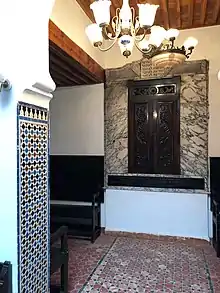
While the AIU failed to achieve much in increasing Moroccan Jews' political status, it did succeed in giving a significant minority of them modern French-language educations and in initiating them into French culture. This included a transformation of many Moroccan Jews' gender and sexual norms. For many centuries, Moroccan Jews and Muslims had shared such customs as polygamy, segregation of the sexes, early ages of female marriage, and a tolerance for men's love of male youths that was in contrast to both Jewish and Islamic scriptural prescriptions.[57] The AIU set out to Europeanize Moroccan Jews' marriage patterns and family forms, combating prostitution, eliminating Jewish women's traditional head coverings, and reining-in on what it saw as Jewish men's promiscuity and homosexual tendencies.[58] These changes required, in the words of an AIU alumni association in Tangiers in 1901, that Jewish mores be "disengaged from the Muslim spirit"[59] – thus helping, like the AIU's activities generally, to increase Moroccan Jews' distance from an emerging Moroccan national identity. Levy Cohen founded the first francophone newspaper in Morocco, Le Reveil du Maroc , in 1883 to spread French language and culture among his coreligionists.[52]
Montefiore's journey to Morocco
_(14748180086).jpg.webp)
In 1863 Sir Moses Montefiore and the Board of Deputies of British Jews received a telegram from Morocco asking for help for a group of Jews who were imprisoned at Safi on suspicion of having killed a Spaniard. Two others had already been executed at the instigation of the Spanish consul; one of them publicly in Tangier, the other in Safi. Sir Moses, supported by the British government, undertook a journey to Morocco to demand the liberation of the imprisoned Jews and, as he said in a letter to the sultan, to move the latter "to give the most positive orders that Jews and Christians, dwelling in all parts of Your Majesty's dominions, shall be perfectly protected, and that no person shall molest them in any manner whatsoever in anything which concerns their safety and tranquillity; and that they may be placed in the enjoyment of the same advantages as all other subjects of Your Majesty." Montefiore was successful in both attempts.[60]
The prisoners were liberated, and on February 15, 1864, the sultan published an edict granting equal rights of justice to the Jews.[61] This edict of emancipation was confirmed by Mohammed IV's son and successor, Moulay Hasan I, on his accession to the throne 1873 and again on September 18, 1880, after the Conference of Madrid.
Pro-Jewish reforms were often not executed by local magistrates in the fragmented sultanate, however, and even if they were they reignited animosity toward the Jewish population. Thus, for example, the sultan Sulaiman (1795–1822) decreed that the Jews of Fez might wear shoes; but so many Jews were killed in the streets of that city as a result of the edict that they themselves asked the sultan to repeal it. According to a statistical report of the AIU, for the years 1864–80 no less than 307 Jews were murdered in the city and district of Morocco, which crimes, although brought to the attention of the magistracy upon every occasion, remained unpunished.[62]
Migration to South America
During this century and up to 1910, around 1000 Moroccan Jewish families migrated to the Amazon, in northern Brazil, during the rubber boom.[63]
| Jewish exodus from Arab and Muslim countries |
|---|
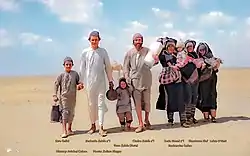 |
| Communities |
| Background |
| Main events |
| Resettlement |
| Advocation |
| Related topics |
Pictorial essay of Jewish community
Early photographs of Moroccan Jewish families, taken in the early 20th century by German explorer and photographer Hermann Burchardt, are now held at the Ethnological Museum of Berlin.[64]
20th century
French Protectorate
The status of Moroccan Jews was not substantially improved by the establishment in 1912 of a French protectorate over much of the country. By contrast with Algeria, where Jews obtained French citizenship en masse with the adoption of the Crémieux decree in 1870, the establishment of the French protectorate in Morocco cost many Jews the forms of European extraterritorial protection they had formerly enjoyed, relegating them once more to the status of indigènes or "natives" along with their Muslim compatriots.[65]
In 1912, amid the insurrection that followed the disclosure of the Treaty of Fes, thousands of rebelling Moroccan soldiers entered and pillaged the Mellah of Fez, stopping only after French artillery rounds pounded the Jewish quarter.[52] More than 50 Jews were killed and hundreds of homes and shops were destroyed or damaged. The events were known as Bloody Days of Fes or the "Tritel." [66]
In Casablanca, the Hadida brothers edited Or Ha’Maarav, or La Lumiere du Maroc (1922-1924), a Zionist[67] newspaper written in Judeo-Arabic with Hebrew script, which ran from 1922 until the French authorities shut it down in 1924.[68][67] It was followed by L'Avenir Illustré (1926-1940) a nationalist, pro-Zionist francophone newspaper, edited by Jonathan Thurz[69][67] as well as l'Union Marocaine (1932-1940), a francophone newspaper in line with emancipatory views of the AIU, edited by Élie Nattaf.[70][67] L'Avenir Illustré and L'Union Marocaine were both shut down by the Vichy regime.[67]
As a community, Moroccan Jews sent significant numbers of children to study in French, at institutions such as the schools of the Alliance Israélite Universelle, a generation or two earlier than Moroccan Muslims.[52] By the 1930s, however, increasing numbers of Moroccan Muslims had also started graduating from schools taught in French, demanding access to positions previously held by French citizens and by Moroccan Jews in French-owned businesses and in the colonial administration.[71]
World War II
In 1940, Résident Général Charles Noguès implemented antisemitic decrees coming from Nazi-controlled Vichy government issued excluding Jews from public functions.[52] Sultan Mohammed V refused "Vichy’s plan to ghettoize and deport Morocco’s quarter of a million Jews to the killing factories of Europe," and, in an act of defiance, insisted on inviting all the rabbis of Morocco to the 1941 throne celebrations.[72][52] However, the French government did impose some antisemitic laws against the sultan's will.[72] Leon Sultan, of the Moroccan Communist Party, for example, was disbarred.[73]
The racist laws had a negative effect on Moroccan Jews and put them in an uncomfortable position "between an indifferent Muslim majority and an anti-Semitic settler class."[52]
In 1948, approximately 265,000 Jews lived in Morocco. Around 2,500 live there now, mostly in Casablanca, but also in Fes and other main cities.
In June 1948, soon after Israel was established and in the midst of the first Arab-Israeli war, riots against Jews broke out in Oujda and Djerada, and in Alcazarquivir killing 44 Jews. In 1948–9, 18,000 Jews left the country for Israel. After this, Jewish emigration continued (to Israel and elsewhere), but slowed to a few thousand a year. Through the early 1950s, Zionist organizations encouraged emigration, particularly in the poorer south of the country, seeing Moroccan Jews as a valuable source of labor for the Jewish State. From 1948 on many Jews left Fes. Most emigrated to Israel while others went to France and Canada. In the 1950s and 1960s there were still active Jewish schools and organizations such as the Alliance Israélite Universelle which later closed as the Jewish population decreased.[5][6][35]
In 1956, Morocco attained independence. Jews occupied several political positions, including three Members of the Parliament of Morocco and a Minister of Posts and Telegraphs. However, emigration to Israel jumped from 8,171 in 1954 to 24,994 in 1955, increasing further in 1956. Beginning in 1956, emigration to Israel was prohibited until 1961, although it continued illegally until it was officially resumed.[74] In 1961, the government relaxed the laws on emigration to Israel, as part of an agreement with Israel that entailed a payment to Morocco for each Jew that left the country for Israel. When Mohammed V died, Jews joined Muslims in a national day of mourning. But over the next three years, more than 80,000 Moroccan Jews emigrated to Israel. By 1967, only 60,000 Jews remained in Morocco.
The Six-Day War in 1967 led to increased Arab-Jewish tensions worldwide including in Morocco. By 1971, its Jewish population was down to 35,000; however, most of this new wave of emigration went to Europe and North America rather than Israel. France for a time was a destination particularly for Moroccan Jews with European educations, who had economic opportunities there; one study of Moroccan Jewish brothers, one of whom settled in France and the other in Israel, showed that 28 percent of the brothers who settled in France became managers, businessmen or professionals (compared to 13 percent of their Israeli brothers) and only 4 percent unskilled workers (compared to over a third of their Israeli brothers).[75] Moroccan Jews in Israel, far more numerous, enjoyed less upward mobility: 51 percent were blue-collar in 1961 and 54 percent as late as 1981.[76]
21st century
Despite their current small numbers, Jews continue to play a notable role in Morocco. The King retains a Jewish senior adviser, André Azoulay. They are well represented in business and even a small number in politics and culture. Jewish schools and synagogues receive government subsidies. However, Jews were targeted in the Casablanca bombings of May 2003. King Hassan II's pleas to former Moroccan Jews to return have largely been ignored.
In 2004 Marrakech had an aging population of about 260 Jews, most over the age of 60, while Casablanca had between 3,000 and 4,000 Jews. A 2014 figure says there are about 2,500 Jews still living in Morocco.[77] As of 2018 the total of Jews in Morocco is 2,200.[78] Meanwhile, the State of Israel is home to nearly 1,000,000 Jews of Moroccan descent, around 15% of the nation's total population.[79]
In 2013, it was revealed that there is a rapidly growing trend of Moroccan-Jewish families sending their sons to study at the Jerusalem College of Technology in Israel. Most of these students opt to take up Israeli citizenship and settle in Israel after graduating.[80] Conversely, a small trickle of criminals from Israel have been settling in Morocco, exploiting the lack of an extradition treaty between the two nations. However, most of these are not of Moroccan descent.[81] There are still many Jewish citizens in Morocco who choose to raise their children in the Jewish faith, and most of those children are sent to the Alliance Israélite Universelle school. However, the majority of students at this school pursue higher education in other countries and leave Morocco.
Gallery
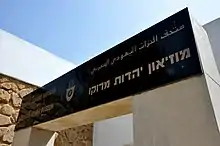 Moroccan Jewish Museum, Casablanca Morocco
Moroccan Jewish Museum, Casablanca Morocco Megillah, Megillat-Hitler, Moroccan Jewish Museum, Casablanca
Megillah, Megillat-Hitler, Moroccan Jewish Museum, Casablanca Jewelry, once belonged to a Jewish family. Moroccan Jewish Museum, Casablanca
Jewelry, once belonged to a Jewish family. Moroccan Jewish Museum, Casablanca Pair of anklets, silver molded, city style. Once belonged to a Jewish woman. Moroccan Jewish Museum, Casablanca
Pair of anklets, silver molded, city style. Once belonged to a Jewish woman. Moroccan Jewish Museum, Casablanca One of the halls at the Moroccan Jewish Museum, Casablanca
One of the halls at the Moroccan Jewish Museum, Casablanca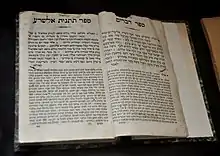 The Book of Deuteronomy, Debarim. Hebrew with translation in Judo-Arabic, transcribed in Hebrew letters. From Livorno, 1894 CE. Moroccan Jewish Museum, Casablanca
The Book of Deuteronomy, Debarim. Hebrew with translation in Judo-Arabic, transcribed in Hebrew letters. From Livorno, 1894 CE. Moroccan Jewish Museum, Casablanca One of the halls at the Moroccan Jewish Museum, Casablanca, Morocco
One of the halls at the Moroccan Jewish Museum, Casablanca, Morocco One of the halls at the Moroccan Jewish Museum of Casablanca, Morocco
One of the halls at the Moroccan Jewish Museum of Casablanca, Morocco A wall sign advising attendants of a Jewish synagogue on what to do during prayer. Moroccan Jewish Museum, Morocco
A wall sign advising attendants of a Jewish synagogue on what to do during prayer. Moroccan Jewish Museum, Morocco
 Entrance Marrakech synagogue
Entrance Marrakech synagogue Synagogue in Marrakech
Synagogue in Marrakech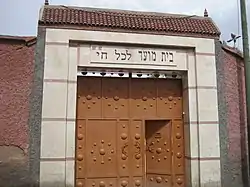 Entrance Jewish cemetery (Marrakech)
Entrance Jewish cemetery (Marrakech) Jewish cemetery (Marrakech)
Jewish cemetery (Marrakech) Zaouit el Bir Dades Cemetery South Morocco
Zaouit el Bir Dades Cemetery South Morocco Moroccan esrog is an unbroken heritage appreciated by the worldwide Jewry
Moroccan esrog is an unbroken heritage appreciated by the worldwide Jewry
See also
- Al Wifaq
- Cicurel family
- History of the Jews in Carthage
- List of Moroccan Jews
- Maghrebi Jews
Notes
- Stearns, Peter N. (ed.). Encyclopedia of World History (6th ed.). The Houghton Mifflin Company/Bartleby.com.
p. 966
- "Jews of Morocco". www.jewishvirtuallibrary.org. Retrieved 2019-02-24.
- Spolsky (2006), p. 1926
- Mercier (1888), p. i. 167
- "The Jewish Community of Fez, Morocco". The Museum of the Jewish People at Beit Hatfutsot. Retrieved 23 June 2016.
- "Virtual Jewish World: Fez, Morocco". Jewish Virtual Library. The Jewish Virtual Library. Retrieved 23 June 2016.
- Norman Roth, Jews, Visigoths, and Muslims in Medieval Spain: Cooperation and Conflict, Brill, 1994, pp.113-116.
- M.J. Viguera. "Almoravids." Encyclopedia of Jews in the Islamic World. Executive Editor Norman A. Stillman. Brill Online, 2014.
- Norman Arthur Stillman, The Jews of Arab Lands, (Philadelphia (Pa.): The Jewish Publication Society of America, 1979), 76.
- (see Ibn Verga "Shebe? Yehudah", ed. Wiener, p. 50
- (see Ibn Verga Eme? ha-Baka", ed. Wiener, p. 20
- Hirschberg (1974), pp. 127–128. Solomon Cohen's account comports with Arab historian Ibn Baydhaq's sequence of events. Citing from The Legacy of Jihad: Islamic Holy War and the Fate of Non-Muslimsby Andrew G Bostom, ed. (Prometheus Books (2005) ISBN 1-59102-307-6 p.612
- C.E. Bosworth, The New Islamic Dynasties, (Columbia University Press, 1996), 41-42.
- "Marīnid dynasty - Berber dynasty". britannica.com. Retrieved 2 April 2018.
- (in French)"Les Merinides" on Universalis
- Niane, D.T. (1981) General History of Africa Vol. IV, pg. 91
- Bernard Lewis, The Jews of Islam, (Princeton University Press, 1984), 151.
- Abd al-Basit b. Khalil, “al-Rawd al-Basim.” Deux recits de voyage inedits en Afrique du Nord au XV siècle, Abdalbasit b Halil et Adorne. (Paris, 1936), quoted in Stillman, Jews of Arab Lands, 281-286.
- Stillman, Norman (1998). The Jews of Arab Lands: A History and Source Book. The Jewish Publication Society. pp. 79–80. ISBN 978-0827601987.
- Gerber, Jane (1997). Jewish Society in Fez, 1450-1700: Studies in Communal and Economic Life. Brill Academic Pub. p. 44. ISBN 978-9004058200.
- Gerber, Jane S.; ג', גרבר (1973). "הדמוגרפיה של הקהילה היהודית בפאס אחרי שנת 1492 / The Demography of the Jewish Community of Fez After 1492". Proceedings of the World Congress of Jewish Studies. 2, DIVISION B: 31–44. JSTOR 23529108.
- Jacobs, Joseph; Schloessinger, Max; Deutsch, Gotthard; Meakin, Budgett. "Morocco". JewishEncyclopedia.com.
- Ibn Verga, "Shebeṭ Yehudah", p. 226
- Kayserling (1865), pp. 143 et seq.
- Kayserling (1865), p. 217
- Kayserling (1865), pp. 155 et seq.
- Kissling et al. (1997), p. 102
- Kissling et al. (1997), p. 260
- "A Man of Three Worlds | Johns Hopkins University Press Books". jhupbooks.press.jhu.edu. Retrieved 2020-03-23.
- See G. B. Ramusio in Leo Africanus, "The History and Description of Africa", ed. R. Brown, iii. 1004, London, 1896
- "Sa'dis". www.jewishvirtuallibrary.org. Retrieved 2 April 2018.
- Chénier, "Recherches Historiques sur les Maures et Histoire de l'Empire de Maroc", ii. 351, Paris, 1787
- Chénier, "The Present State of the Empire of Morocco", i. 354, London, 1788; compare Jost (1828), pp. viii. 42 et seq.
- Chénier, "Recherches Historiques sur les Maures et Histoire de l'Empire de Maroc", i. 326
- Miller, Susan Gilson; Petruccioli, Attilio; Bertagnin, Mauro (September 2001). "Inscribing Minority Space in the Islamic City: The Jewish Quarter of Fez (1438-1912)". Journal of the Society of Architectural Historians. 60 (3): 310–327. doi:10.2307/991758. JSTOR 991758.
- Cazorla, Frank, G. Baena, Rose, Polo, David, Reder Gadow, Marion (2019) The governor Louis de Unzaga (1717-1793) Pioneer in the birth of the United States of America. Foundation. Malaga. pages 84-1010
- Chénier, "The Present State of the Empire of Morocco", i. 341
- Jost (1828), p. 45
- Jost (1828), pp. 44 et seq.
- "Morocco Virtual Jewish History Tour". www.jewishvirtuallibrary.org. Retrieved 2 April 2018.
- D. Kaufmann, "Z. D. M. G." l. 238 et seq.; "R. E. J." xxxvii. 120 et seq.
- Chénier, "The Present State of the Empire of Morocco", i. 157
- Picciotti, "Sketches of Anglo-Jewish History" p. 173, London, 1875
- Meakin, "The Moors", London, 1902
- Jean-Louis Miège, L'ouverture, vol. 2 of Le Maroc et l'Europe, Paris: Presses Universitaires de France, 1961, 569
- Mohammed Kenbib, Juifs et musulmans au Maroc, 1859–1948, Rabat: Université Mohammed V, 1994, 431-33
- Gottreich, Emily R. Jewish space in the Morroccan city : a history of the mellah of Marrakech, 1550-1930. p. 54. OCLC 77066581.
- Schroeter (2002), p. 150
- Miller (1996), p. 235
- Jost, Neuere Gesch. der Israeliten, ii. 220, Berlin, 1846
- H. Iliowizi, Through Morocco to Minnesota, 1888, p. 49
- Miller, Susan Gilson (2013). A History of Modern Morocco. Cambridge: Cambridge University Press. p. 45. doi:10.1017/cbo9781139045834. ISBN 978-1-139-04583-4.
- Rodrigue, Aron (2003). Jews and Muslims: Images of Sephardi and Eastern Jewries in Modern Times. University of Washington Press. ISBN 978-0-295-98314-1.
- Emily Gottreich, The Mellah of Marrakesh: Jewish and Muslim Space in Morocco's Red City, Bloomington: Indiana University Press, 2007, 9
- Katz (2011), p. 283
- André Chouraqui, L'Alliance Israélite Universelle et la Renaissance Juive Contemporaine (1860–1960), Paris: Presses Universitaires de France, 1965, 58
- Drucker (2015), pp. 4, 15
- Drucker (2015), pp. 7, 10–15
- Marglin (2011), pp. 595–596
- Parfitt (2000)
- Diaries of Sir Moses and Lady Montefiore", ii. 145 et seq., London, 1890; see also the account of the journey by Dr. Thomas Hodgkin, the physician who accompanied Montefiore, entitled "Narrative of a Journey to Morocco", London, 1866
- Bulletin de l'Alliance Israélite Universelle, No. 2, p. 17, Paris, 1880
- Schuessler, Ryan (2016-08-18). "Dwindling Amazon Jewish community keeps faith despite religious exodus". The Guardian. ISSN 0261-3077. Retrieved 2020-03-22.
- Jewish couple in Morocco on the roof of their house; Jewish family during the Feast of Tabernacles on the roof of their house; Moroccan Jews in 1905, by Hermann Burchardt; Jewish family, 1905; The Saba Synagogue, 1905; Jewish family in their home; The Ibn (Aben) Danan Synagogue, in the Mellah of Fès (click to enlarge); Jewish family in Morocco, early 20th century (click on photo to enlarge).
- Laskier (1983), p. 39
- Jews in Morocco: The Fez Pogrom of 1912
- Bensoussan, David (May 2012). Il tait Une Fois Le Maroc: Tmoignages Du Pass Judo-marocain. iUniverse. ISBN 978-1-4759-2608-8.
- "La Lumiere du Maroc (Or Ha'Maarav)". web.nli.org.il. Retrieved 2020-03-23.
- "L'Avenir Illustré". web.nli.org.il (in French). Retrieved 2020-03-23.
- Laskier, Michael M. (2012-02-01). Alliance Israelite Universelle and the Jewish Communities of Morocco, 1862-1962, The. SUNY Press. ISBN 978-1-4384-1016-6.
- Laskier (1983), pp. 286, 293
- Moroccan Jews pay homage to `protector' – Haaretz Daily Newspaper | Israel News. Haaretz.com. Retrieved on 2011-07-04.
- "Le Petit Marocain". Gallica. 1945-06-24. Retrieved 2020-03-22.
- ''Prohibitions on Communications and Emigration to Israel''. Rickgold.home.mindspring.com. Retrieved on 2011-07-04.
- Michael Inbar and Chaim Adler, Ethnic Integration in Israel: A Comparative Study of Moroccan Brothers Who Settled in France and in Israel, New Brunswick: Transaction, 1977, 35-36, 45
- Eliezer Ben-Rafael and Stephen Sharot, Ethnicity, REligion, and Class in Israeli Society, Cambridge: Cambridge University Press, 1991, 67
- "The Jews of Morocco". The Museum of the Jewish People at Beit Hatfutsot.
- "Statistical Abstract of Israel 2009 - No. 60 Subject 2 - Table NO.24". Israeli government. Retrieved 12 December 2011.
- "Moroccan Jews study high-tech in Israel". ynetnews.com. 17 March 2013. Retrieved 2 April 2018.
- Kubovich, Yaniv (14 September 2012). "New Destination for Alleged Israeli Mobsters on the Run: Morocco". Retrieved 2 April 2018 – via Haaretz.
References
- Boum, Aomar (2014). Memories of Absence: How Muslims Remember Jews in Morocco. Stanford: Stanford University Press. ISBN 978-0804795234.
- Behar, Doron M.; Metspalu, Ene; Kivisild, Toomas; Rosset, Saharon; Tzur, Shay; Hadid, Yarin; Yudkovsky, Guennady; Rosengarten, Dror; Pereira, Luisa; Amorim, Antonio; Kutuev, Ildus; Gurwitz, David; Bonne-Tamir, Batsheva; Villems, Richard; Skorecki, Karl (2008). "Counting the founders. The matrilineal genetic ancestry of the Jewish Diaspora". PLOS One. 3 (4): e2062. doi:10.1371/journal.pone.0002062. PMC 2323359. PMID 18446216.
- Drucker, Peter (March 2015). "Disengaging from the Muslim spirit: the Alliance Israélite and Moroccan Jews". Journal of Middle East Women's Studies. Duke University Press. 11 (1): 3–23. doi:10.1215/15525864-2832322. S2CID 144370868.
- Hirschberg, H. Z. (1974). A History of the Jews of North Africa. I. Leiden: Brill.
- Jost, Isaak Markus (1828). Geschichte der Israeliten seite der Zeit der Maccabäer bis auf unsre Tage. Berlin: Schlesinger.
- Katz, Jonathan G. (2011). "'Les Temps Héroïques': the Alliance Universelle Israélite Universelle on the eve of the French Protectorate". In Emily Gottreich & Daniel J. Schroeter (ed.). Jewish Culture and Society in North Africa. Bloomington, Indiana: Indiana University Press. pp. 282–301. ISBN 9780253001467.
- Kayserling, Meyer (1865). Geschichte der Juden in Portugal [History of the Jews in Portugal] (in German). Berlin.
- Kissling, Hans J.; Spuler, Bertold; Barbour, N.; Trimingham, J. S.; Bagley, F. R. C.; Braun, H.; Hartel, H. (1997). The Last Great Muslim Empires: History of the Muslim World. Brill.
- Laskier, Michael (1983). The Alliance Israélite Universelle and the Jewish Communities of Morocco, 1862–1962. Albany, New York: State University of New York Press. ISBN 9780873956567.
- Marglin, Jessica (2016). Across Legal Lines: Jews and Muslims in Morocco. New Haven: Yale University Press. ISBN 978-0300218466.
- Marglin, Jessica (2011). "Modernizing Moroccan Jews: the AIU Alumni Association in Tangiers, 1893–1913". Jewish Quarterly Review. 101 (4): 574–603. doi:10.1353/jqr.2011.0039. S2CID 162331381.
- Mercier, E. (1888). Histoire de l'Afrique Septentrionale [History of North Africa] (in French). Paris.
- Miller, Susan G. (1996). "Gender and the poetics of emancipation: the Alliance Israélite Universelle in northern Morocco, 1890–1912". In L. Carl Brown & Matthew S. Gordon (ed.). Franco-Arab Encounters: Studies in Memory of David C. Gordon. Beirut: American University of Beirut. pp. 229–252.
- Parfitt, Tudor (2000). "Dhimma versus protection in 19th century Morocco". In Parfitt Parfitt (ed.). Israel and Ishmael: Studies in Muslim–Jewish Relations. SOAS Near and Middle East Publications. London: Curzon. pp. 142–166. ISBN 9780700710911.
- Schroeter, Daniel J. (2002). The Sultan's Jew: Morocco and the Sephardi World. Stanford, California: Stanford University Press. ISBN 9780804737777.
- Spolsky, Bernard (2006). "Israel and the Jewish languages". In Ulrich Ammon (ed.). Sociolinguistics. Handbooks of Linguistics and Communication Science. 3 (2nd ed.). Walter de Gruyter. pp. 1924–1930. ISBN 9783110199871.
- Stillman, Norman A. (1991). The Jews of Arab Lands in Modern Times. Philadelphia: Jewish Publication Society.
![]() This article incorporates text from a publication now in the public domain: Singer, Isidore; et al., eds. (1901–1906). "Morocco". The Jewish Encyclopedia. New York: Funk & Wagnalls.
This article incorporates text from a publication now in the public domain: Singer, Isidore; et al., eds. (1901–1906). "Morocco". The Jewish Encyclopedia. New York: Funk & Wagnalls.
Further reading
- David Bensoussan, Il était une fois le Maroc : témoignages du passé judéo-marocain, éd. du Lys, www.editionsdulys.ca, Montréal, 2010 (ISBN 2-922505-14-6). Second edition : www.iuniverse.com, Bloomington, Indiana, 2012, ISBN 978-1-4759-2608-8, 620p. ISBN 978-1-4759-2609-5 (ebook);
External links
- Moroccan Daily Halakha / La Halakha Marocaine Quotidienne
- History of Jews in Fez and Morocco (in French)
- Dafina.net Moroccan Jews Website in French and English:history, culture, food, forum...
- Jewish Virtual Library
- Visiting Jewish Morocco A very complete and informative site about history and culture of Moroccan Jews
- Jewish Moroccan Heritage The Museum of Moroccan Jews (French) very rich, a lot of interesting material.
- The Mellahs Of Southern Morocco A report of a survey by Harvey E. Goldberg
- Jewish existence in a Berber environment By Moshe Shokeid
- A list of Moroccan synagogues
- Moroccan Jews in the Amazon and the rubber trade
- Chabad-Lubavitch Centers in Morocco
- Moroccan Jews website, Darnna.com
- Agadir Jewish Community Website Pictures of Tombgraves of the cemetery of Agadir
- Moroccan judaism museum The website of Le musée du judaisme marocain, a museum about the Jewish heritage in Morocco. (in French)
- http://sites.google.com/site/moroccanjews/jews-in-morocco. Haim Cohen, leader of the Jews in Spanish Morocco, writes a report to Ahmed Belbachir Haskouri in November 1947 on the state of the Jews and recommends steps for enhancement of this community in Spanish Morocco. This decline was due to a substantial emigration of Jews from Morocco in the immediate wake of the partition in Palestine.
- Diana Muir Appelbaum "The Last Berber Jews", Jewish Ideas Daily, Aug. 10, 2011,
- Return to Morocco, Al Jazeera
- Gressel, Madeline, Zoe Lake, Siyi Chen, Kelsey Doyle and Khadija Boukharfane. "In Morocco, Muslims and Jews study side-by-side but for how long?" (Archive). PBS Newshour. July 29, 2015.
